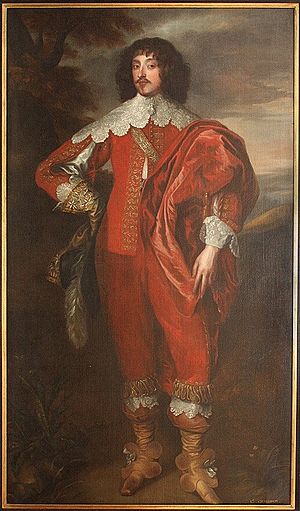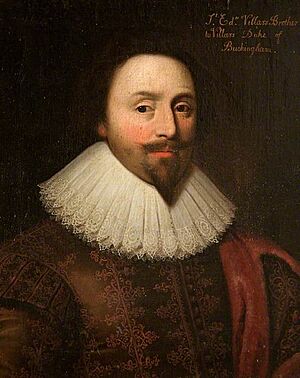William Villiers, 2nd Viscount Grandison facts for kids
Quick facts for kids
William Villiers, 2nd Viscount Grandison
|
|
|---|---|

William Villiers, 2nd Viscount Grandison
|
|
| Personal details | |
| Born | 1614 London |
| Died | 23 September 1643 (aged 29) Oxford |
| Resting place | Christ Church Cathedral, Oxford |
| Nationality | English |
| Spouse | Mary Bayning (1639-his death) |
| Children | Barbara Villiers (1640-1709) |
| Occupation | Courtier and soldier |
| Military service | |
| Rank | Colonel |
| Battles/wars | Bishops' Wars First English Civil War Edgehill; Bristol |
William Villiers, 2nd Viscount Grandison (born 1614 – died 23 September 1643) was an Irish nobleman and a soldier who supported the King during the First English Civil War. He was seriously injured in battle in 1643 and later died from his wounds.
Contents
About William Villiers
William Villiers was born in London in 1614. He was the oldest son of Sir Edward Villiers (1585-1626) and Barbara St. John (around 1592-1672). His father was the older half-brother of George Villiers, 1st Duke of Buckingham. This Duke was a favorite of both King James VI and I and King Charles I. This family connection helped William's father a lot.
William had nine brothers and sisters. Some of them were Anne (1610-1654), John (1616-1659), George (1618-1699), Barbara (1618-1681), and Edward (1620-1689). The Villiers family was very powerful and had many important connections. For example, William's relatives included John Villiers, 1st Viscount Purbeck and Christopher Villiers, 1st Earl of Anglesey. His relative Susan Feilding was a close attendant to Queen Henrietta Maria.
In 1639, William Grandison married Mary Bayning (1623-1672). She was very wealthy. They had one daughter, Barbara Villiers (1640-1709). Barbara later became an important figure at the court of King Charles II. After William's death, Mary married his cousin, Christopher Villiers.
Becoming Viscount Grandison
William Villiers grew up mostly in London. His father worked as the Master of the Mint, which meant he had rooms at the Tower of London.
On June 23, 1623, William's great-uncle, Oliver St John (1559–1630), was given the title of Viscount Grandison. This was a title in the peerage of Ireland. Oliver St John had no children. So, the title was set up so that it would pass to the male heirs of his niece, Barbara Villiers. This meant that when Oliver St John died in December 1630, William Villiers inherited the title. He became the 2nd Viscount Grandison.
Military Career
In 1638, King Charles I made Grandison a knight at Windsor. The Prince of Wales (who would later become King Charles II) was also knighted at the same time.
During the Bishops' Wars in 1639 and 1640, Grandison was made a Colonel. However, it seems he did not fight in any battles during these wars.
When the First English Civil War began in August 1642, Grandison formed his own group of cavalry soldiers. These soldiers were part of the King's army, known as the Royalists. They fought on the left side of the Royalist army at the Battle of Edgehill on October 23. During this battle, the King's flag was captured by the enemy. But three men, led by John Smith, an officer in Grandison's group, managed to get it back. Smith was made a knight right there on the battlefield. He was the last knight banneret ever created in England. Grandison also promoted Smith to major. Sadly, Smith was later killed in another battle in 1644.
Wounded at Bristol
On July 26, 1643, during the Storming of Bristol, Grandison led one of three large groups of soldiers. These groups were commanded by Prince Rupert of the Rhine. Grandison's group attacked a fort called Prior's Hill Fort and another defense point. During their third attack, he was shot in his right leg. His cousin, Edward St John, was also wounded.
Grandison was taken to Oxford for treatment. He died there on September 29, 1643. It is believed he died from a fever caused by his injury.
Since Grandison did not have a son, his younger brother, John Villiers, became the 3rd Viscount Grandison. After the King returned to power in England (this was called the Restoration), Grandison's only child, Barbara Villiers, became a very important person at the court of King Charles II. In 1670, she was given the title of Duchess of Cleveland. She became the ancestor of several important noble families. Grandison's mother, Barbara Lady Villiers, lived a long life and saw the King return to power.
William's youngest brother, Edward, was the father of Edward Villiers, 1st Earl of Jersey. The current Viscount Grandison, William Villiers (born in 1976), is a descendant of this family line.
Lydiard Portrait
A painting of William Grandison is still kept at Lydiard House. This was his mother's family home in Wiltshire. The painting is thought to be from the school of the famous artist Anthony van Dyck. At the bottom right of the painting, it says "LD. GRANDISSON".
Around 1714, an artist named Pieter van Gunst made an engraving (a print) of this painting. He identified it as "William Villiers, Vicount Grandisson, Father to ye Late Duchesse of Cleaveland." He also said it was painted by A v. Dyk.
Images for kids




